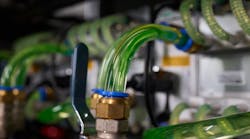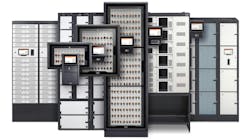Three Key Rear Door Cooler Features for Modern Data Centers: It’s Not Just About Capacity
Commissioning and deploying cooling and networking for data centers is a challenge, particularly as data centers evolve to meet the needs of fast-growing and ever-changing IT infrastructure. Rear door coolers can help drive efficient operations in data centers, and offer flexibility in planning for infrastructure before it is installed. However, rear door cooler landscape is shifting, with customers placing more emphasis on features, and less on power.
For many years, data center managers looking to deploy rear doors were focused on one core question: How many KW of IT can your rear door cooler handle? Now, while capacity is still important, rear door coolers are often used in tandem with direct-to-chip cooling which offsets the highest heat loads. The function of the rear door is no longer to cool the hottest IT on its own, but rather to provide an incredibly reliable, always-on baseline level of cooling that can efficiently handle the cooling of any IT in a rack that is not covered by direct-to-chip.
This shift in the way that data center managers are thinking about deploying rear doors naturally impacts what characteristics of rear doors are considered to be the most valuable in the industry. Instead of doors with extreme cooling capacity, data center managers are looking for doors that offer high levels of redundancy and efficiency, adding reliability and consistency to their operations. For racks that can contain millions of dollars in IT, maintaining safe operating temperatures is critical for business continuity.
Here are the kinds of features we are seeing data center mangers prioritize:
Pressure, Temperature and Water Sensing
In today’s environment of ever-expanding IT infrastructure and increased pressure to use power and water sustainably, sensing and monitoring is critical. Data center managers are looking for rear doors that can monitor and modulate fan speeds based on air pressure, temperature, and water flow, providing multiple layers of sensor redundancy.
In the past, data center managers were often asked to manually check the pressure of rear doors—if pressure was too high due to a misalignment in rear door and server fan speeds, they would hear a pop when the door opened. Those days are gone: sensors can do a far more accurate job without disrupting critical data center operations. Screens on the front of the rear door should also be able to provide real-time data on pressure, water temperature and fan speed. In the rare instance that all three sensors fail, rear door controllers need to allow for manual overrides to maintain continuous operation.
Redundancy and Hot Swappable Components
Once turned on, data center managers should be able to run rear door coolers continuously. Yet, over time, some components of rear doors will inevitably need to be serviced or replaced. Hot-swappable fans are nonnegotiable—shutting off an entire rear door to replace a single fan is simply not an option for data center managers. However, this serviceability needs to extend beyond fans. Failures or service needs in controllers and power supplies can add downtime risk unless doors are set up to allow maintenance without shutting down the door. Importantly, all of this maintenance should also be able to be done from the front of the door, with the door closed. Ethernet connectivity should also be redundant to allow multiple network connections.
WebGUI Interfaces
Remote monitoring and control is critical in today’s high-pressure data center environment. Data center managers need to be able to quickly and dynamically respond to changing needs even from remote locations. Users should be able to log in remotely to update firmware, monitor power consumption and adjust settings on their rear doors.
This remote monitoring can be quite detailed with the proper configuration, able to show power consumption at the level of each individual door, alongside other important performance metrics. The control interfaces of rear door coolers should also be very customizable as different data center managers may have different needs.
About the Author

Sam Dore
Sam Dore is nVent’s Product Manager for Liquid Cooling in Europe. He previously worked in local, national and European sales roles from the UK, as well as in Global Product Management. Primarily from the ventilation sector, Sam has spent the past 18 years within the building services and HVAC markets championing sustainability and energy efficiency.



